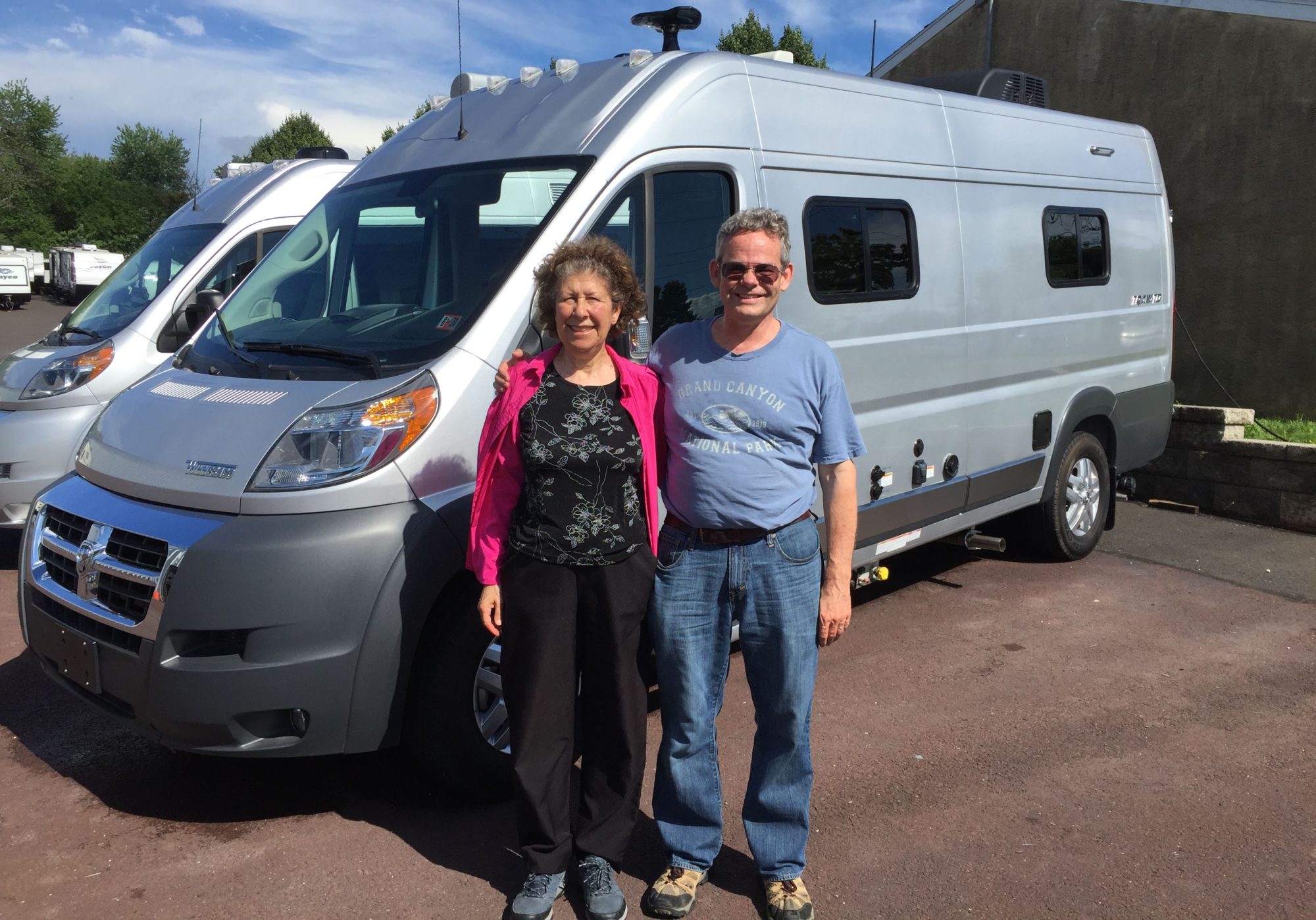Tucson (Nov 21)
We rolled into the Tucson/LazyDaze KOA on Tuesday evening. It is a very big resort-type KOA, with 2 swimming pools (both open, since the temperature here is hot!) a large lounge and a restaurant. They also have an events tent, where they held a Thanksgiving dinner.
The campground also has two large roofs supporting solar panels. If you park beneath these roofs, you get some much needed shade. The sun here is relentless. (However, we did not park in that area.)
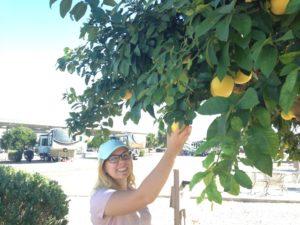 The campground, although favoring desert landscaping as is the usual now, has a lot of trees. Most of these are citrus trees – oranges, lemons, grapefruits and limes. Although it is a bit early in the season, much of the fruit was ripe and guests are encouraged to use it. I enjoyed oranges and grapefruits during our say and also came away with a few lemons for future use. Here is Rebecca picking a grapefruit.
The campground, although favoring desert landscaping as is the usual now, has a lot of trees. Most of these are citrus trees – oranges, lemons, grapefruits and limes. Although it is a bit early in the season, much of the fruit was ripe and guests are encouraged to use it. I enjoyed oranges and grapefruits during our say and also came away with a few lemons for future use. Here is Rebecca picking a grapefruit.
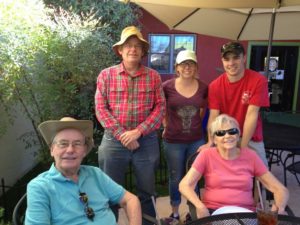 Our primary objective for this visit was to spend Thanksgiving with Chuck’s parents, who have a house in a lovely suburban development. Our nephew Jake and his girlfriend Rebecca who graduated from U. Maine in May and are now living in Phoenix, also came for the week to stay with my in-laws. We spent a lot of time with the family, enjoying meals out, Thanksgiving dinner and lots of left-overs, as well as women’s college basketball – some UConn fans in the crowd.
Our primary objective for this visit was to spend Thanksgiving with Chuck’s parents, who have a house in a lovely suburban development. Our nephew Jake and his girlfriend Rebecca who graduated from U. Maine in May and are now living in Phoenix, also came for the week to stay with my in-laws. We spent a lot of time with the family, enjoying meals out, Thanksgiving dinner and lots of left-overs, as well as women’s college basketball – some UConn fans in the crowd.
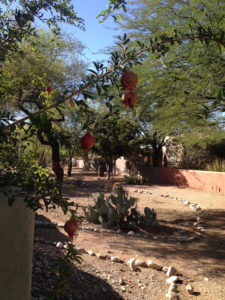
The neighborhood is a typical Tucson suburb, with lots of low-rise adobe style homes and desert landscaping. I stopped to chat with the owner of this pomegranate tree, who gave me some fruit and an abbreviated version of her life story, which included being an air force parachutist.
I have to say that between the weather – very hot in the sun, but quite lovely in the shade – and the amazing scenery, I was quite taken by the Tucson lifestyle.
Jake is uber-good at motor vehicle repairs including cars, trucks and RVs. We took advantage of this by hiring him to do some work on the RV. He adjusted our suspension system and also installed a mud guard. The latter proved to be much trickier than the former.
While we were at it, we also decided to get a memory foam topper for our mattress. We were shocked, when we lifted the mattress, to find that the bottom was moldy (thus explaining why I seemed to be allergic to Tucson, a place where people move to alleviate their allergies). The internet informed me that this is a frequent problem with RV and boat mattresses, which lie on solid (usually plywood) frames rather than bedsprings. The bottom of the frame is cold. The mattress is warm and porous and has moist bodies resting on it. As a result, there is condensation between the mattress and the frame. We put the mattress outside in the dry air under the hot Tucson sun and scrubbed it down with bleach. We also bleached and scrubbed down the plywood. This seems to have solved the problem, but we will start airing the bed weekly. In the long term, we need to get some type of spring or porous matting to place between the bed and the plywood.
We did not do much sightseeing in Tucson, but we did take a few hours to drive through part of the Saguaro National Park. New Mexico is the Chichuahuan Desert. Most of the plants are scrubby, with a lot of yuccas, a few shurbs and some agave. The main cactus are prickly pears and a basic cholla, except where humans have planted. Tucson is the Sonoran Desert. It has some archetypal desert features – especially the many types of cactus, such as saguaro and barrel cactus, and many types of very spiny chollos like the one of the right below. The bushes behind Chuck are regular leafy plants when there is enough moisture, but the fuzzy looking clump is a cactus and that fuzz is made up of needle sharp and very strong spines.
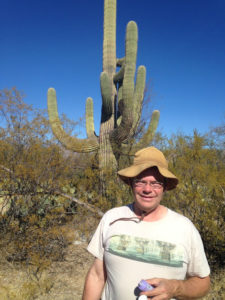
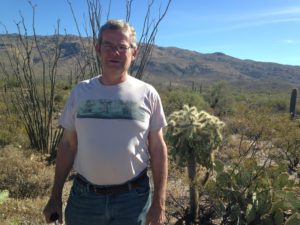
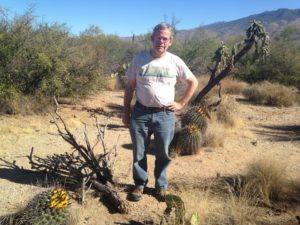 The entire Tucson area has a lot of cactuses, both in gardens and growing wild where there might be weeds or underbrush in other parts of the country. Saguaro National Forest is literally a forest of huge saguaro cactuses, along with many other types of cactuses (or is it cacti?) agaves, and dry-land plants. In the photo to the left, Chuck is posing with several barrel cactuses (in bloom) and one of the types of cholla.
The entire Tucson area has a lot of cactuses, both in gardens and growing wild where there might be weeds or underbrush in other parts of the country. Saguaro National Forest is literally a forest of huge saguaro cactuses, along with many other types of cactuses (or is it cacti?) agaves, and dry-land plants. In the photo to the left, Chuck is posing with several barrel cactuses (in bloom) and one of the types of cholla.
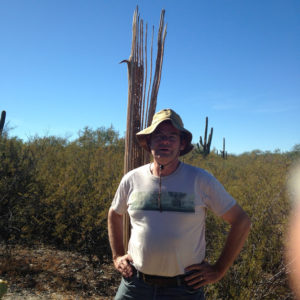 The saguaro is able to grow so tall and support its large branches because its main stem is made up of woody supports as shown to the left. When the plant is alive, the pulpy flesh between the supports is a perfect place for insects and birds to burrow, and the forest is alive with bird, insect and animal life.
The saguaro is able to grow so tall and support its large branches because its main stem is made up of woody supports as shown to the left. When the plant is alive, the pulpy flesh between the supports is a perfect place for insects and birds to burrow, and the forest is alive with bird, insect and animal life.
We were surprised to learn that the cactus forest had been depleted in the 1920s, not directly by humans, but by cold weather that killed many of the cactuses. Grazing cattle made it difficult for the young seedlings to replenish the forest. (How the cattle manage with seriously thorny plants everywhere, including underfoot, I do not know). To preserve some of the forest, the Saguaro National Forest was established, with exclusion areas to keep the cattle out. There is now a high density of huge saguaros – in some ares laooking very similar to photos taken before the bad weather hit.
There are several short trails through the forest that are sufficiently cleared that Rumple could walk on them There are some longer trails, which we are leaving until our Xmas visit with our kids.
We decided that we would end our trip before Xmas, and so we are heading east next.
